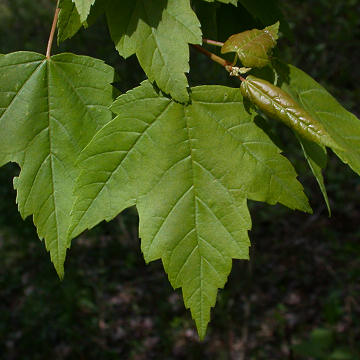

Acer rubrum - (image 1 of 7)
Taxonomy
Family: Aceraceae
Habitat
An adaptable species but most often associated with swampy habitats or moderately moist, upland soils.
Associates
Distribution
Southern Ontario east to New Brunswick, and south to central FL and west to eastern TX.
Morphology
Leaves 6 to 10 cm in diameter, palmately 3-lobed (occasionally with 5 lobes) with acute sinuses; margin of the lobes serrate; pale green above and glaucous below. Stems dark red with tiny lenticels; buds blunt with the terminals larger than laterals. Flowers perfect, appearing very early in spring before the foliage; yellow to bright red. Young bark smooth and light gray. Older bark breaking up into long, narrow, scaly plates. Height to 70 feet; occasionally much taller.
Notes
Flowers late March to early May
Wetland Indicator: Facultative
A fast growing tree that is attractive in the landscape. Fall color can be a brilliant red. Prefers acid soil and will develop chlorosis badly in alkaline soils. Wilted leaves are highly toxic to horses. The hybrid of this species with Acer saccharinum is called Acer x freemanii. The hybrid is a good street tree that maintains many of the better characteristics of A. rubrum without the sensitivity to alkaline soils.
References
Gleason, Henry A.
and A. Cronquist. 1991. Manual of Vascular Plants of Northeastern United States
and Adjacent Canada. Second Ed.
The New York Botanical Garden. Bronx, NY
Hardin, J.W., D. J. Leopold, and F.M. White. 2000. Harlow and Harrar’s Textbook of Dendrology. Ninth Ed.
McGraw-Hill. New York.
Swink, F. and G.
Wilhelm. 1994. Plants of the Chicago Region.
Indiana Academy of Science. The Morton Arboretum. Lisle, Illinois.
|
© Michael Hough 2004 |